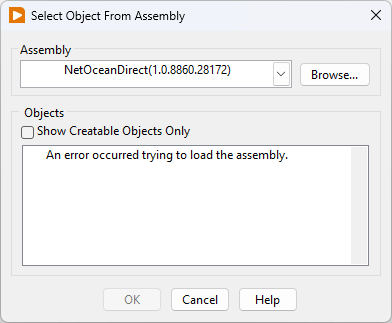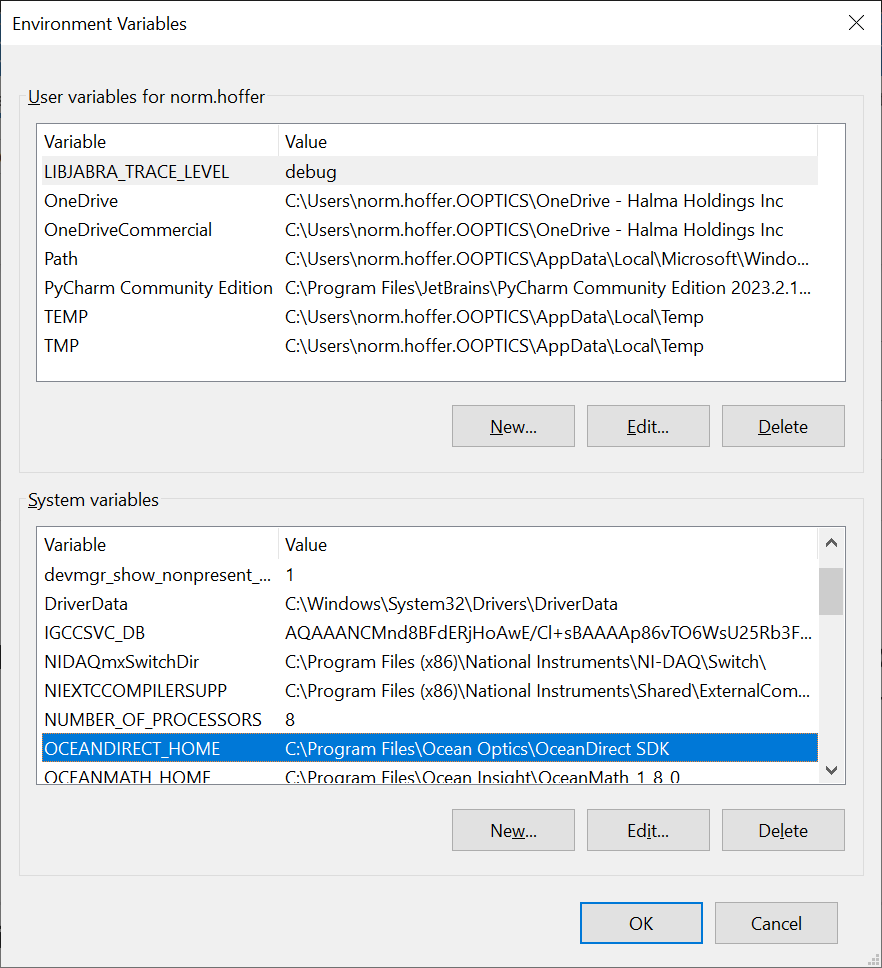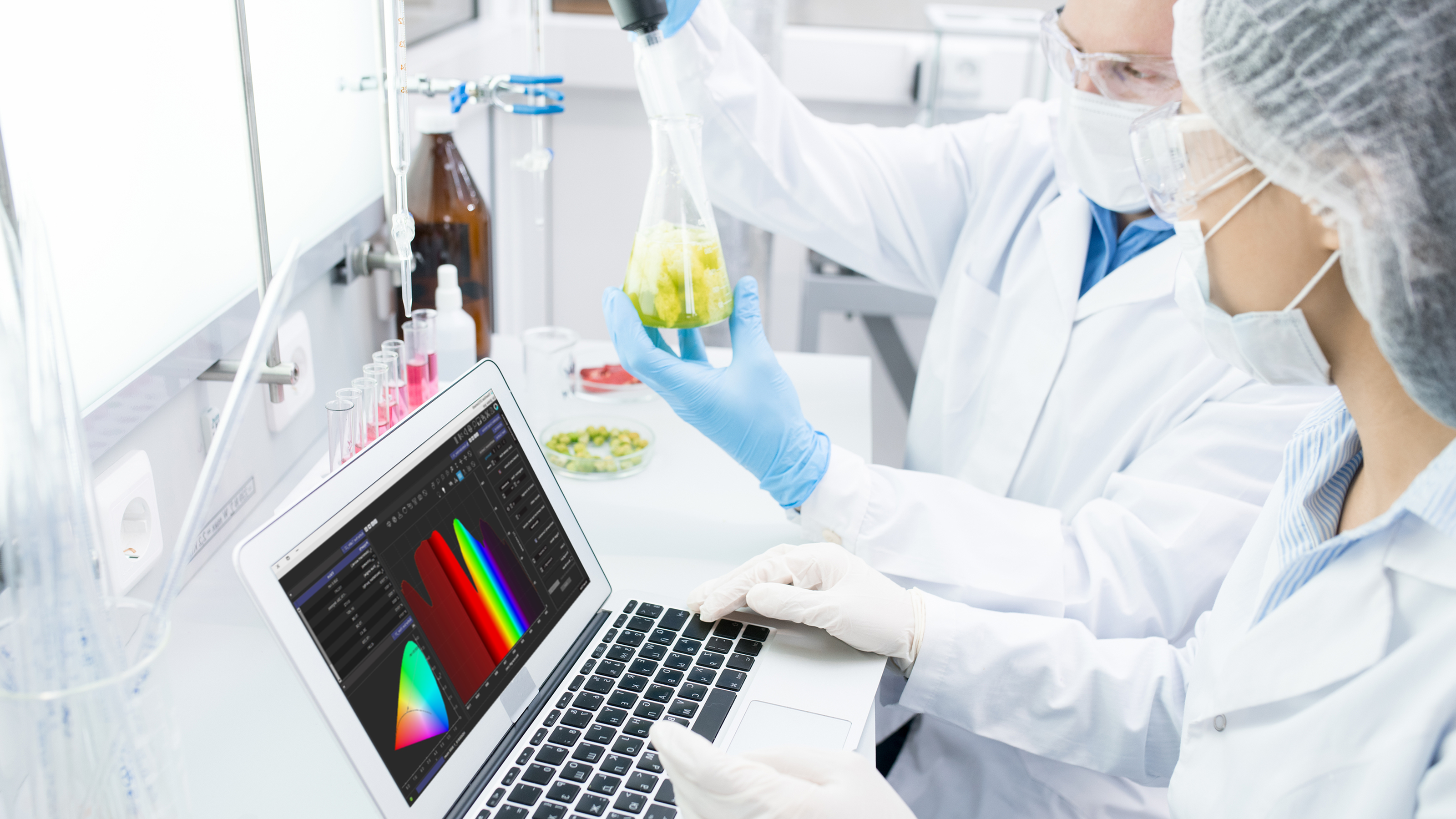What is the status of Overture, Quantum, OceanART, NanoQuest and SpectraSuite?
These software tools are obsolete, and we do not support them. The replacement is OceanView, if you do not have it, please contact sales or customer service.
What is the difference between relative irradiance and absolute irradiance?
The difference lies in how each mode calibrates the spectrometer and the type of data it provides. Both terms should be called spectral irradiance.
Relative spectral irradiance mode corrects for wavelength-dependent responsivity using a known incandescent lamp and accounts for the Instrument Response Function (IRF). It ensures the spectral shape is accurate, allowing for comparison of power at different wavelengths within the same spectrometer. This mode is suitable when you need to determine the spectral shape or compare heights of peaks at different wavelengths.
Absolute spectral irradiance mode involves calibrating the spectrometer against an SI traceable radiometric standard, providing a direct measurement of light intensity. This mode is necessary when you need to quantify the actual power of light at different wavelengths.
For ratio-based measurements like absorbance, where you compare power at the same wavelength on the same device, neither mode is required.
Summary: Use relative spectral irradiance mode for comparing power at different wavelengths within the same spectrometer, ensuring an accurate spectral shape. Use absolute spectral irradiance mode when you need precise quantification of light intensity. For ratio-based measurements at the same wavelength on the same device, neither mode is necessary. Choose the appropriate mode based on your measurement goals and analysis requirements.
How do I set up irradiance calibrated spectrometer to measure lamp output power?
You have your equipment and are ready to get started. Visit Measuring Lamp Output Power page to follow the steps to measure successfully your lamp or light source output power.
I’m getting started in OceanView and don’t understand how best to use the data acquisition parameters that are available. What do I need to know?
Understanding the key data acquisition parameters available in OceanView will help ensure best results for your spectral measurements. This is important even if you’re using one of OceanView’s wizards, which guide you through the steps for specific measurements (absorbance, color and so on) but still require you to input most data acquisition parameters.
Integration Time
This is the first parameter that you will set. Integration time is the period of time over which the spectrometer collects photons and correlates with the intensity of the signal that is captured. We find that the best measurements are made when the signal intensity is between 80% and 90% of its full range. When setting integration time, be careful not to allow any pixels to become saturated, as these pixels will not provide useful data.
Quick tip: In OceanView 2.0.8 and higher versions, there’s a convenient feature that automatically selects the integration time appropriate for your setup. Activating this feature is as simple as selecting the Automatic option in the Acquisition Group Window of OceanView.
Scans to Average
This time-based averaging function specifies the number of discrete spectral acquisitions that the device driver accumulates before OceanView receives a spectrum. The higher the value, the better the signal-to-noise ratio (SNR). The SNR will improve by the square root of the number of scans averaged.
Boxcar Width
Boxcar smoothing is a technique that averages a group of adjacent detector elements across spectral data. For example, a boxcar width value of 5 averages each data point with 5 points to its left and 5 points to its right.
The greater the boxcar width value, the smoother the data and the higher the SNR. If the value entered is too high, a loss in spectral resolution will result and peaks will become flattened. The SNR will improve by the square root of the number of pixels averaged.
Electric Dark Correction
Many spectrometers have a small number of dark pixels. A dark pixel is an electrically active CCD detector pixel that has been physically coated to prevent any light from entering. Due to leakage, a small amount of electrons escape from the detector well even if there is absolutely no light.
To eliminate any error due to leakage, electric dark correction computes an average value of these dark pixels over 15 consecutive scans, and then subtracts this average value from all pixels in the spectrum. Although the algorithm specifies that 15 consecutive scans be averaged, the correction factor is applied as soon as the first spectrum of data becomes available. Then additional scans are averaged into the correction factor as these spectra become available. A running average of the most recent 15 scans is maintained.
The amount of electron leakage is proportional to the duration of the integration time. So, whenever the integration time is changed, the previous correction factor is discarded and we then begin to compute a new correction factor based entirely on the new integration time.
Non-linearity Correction
All Ocean Optics spectrometers are calibrated at the factory to maximize accuracy. One of the calibrations performed is to correct for detector non-linearity. This calibration consists of eight numbers used as the coefficients of a 7th order polynomial, which adjusts for the phenomenon that CCD detectors do not respond to stimuli photons uniformly as more electrons drain from the detector well. In other words, the efficiency of CCD detectors may be 30% when the well is half-full but may be only 20% when the well is completely drained of electrons.
By “efficiency” we mean the probability that an incoming photon will drain an electron from the CCD well; 100% efficiency means every incoming photon will drain one electron, while 50% efficiency means an incoming photon has only a 50% chance of causing an electron to drain. Non-linearity calibration is made by averaging together all pixels of the CCD array. Thus, we are assuming that all pixels respond about the same.
Quick tip: Detector linearity is different than absorbance linearity, which is associated with Beer’s Law.
What’s the difference between EZ and Advanced modes in OceanView software?
Options are great but can sometimes be overwhelming. So, in response to customer feedback, we updated OceanView to offer a simpler version with fewer functions. Now, in OceanView versions 2.0.8 and higher, users can switch between two modes: EZ and Advanced.
How to Determine Current OceanView Mode
When OceanView software is first installed, the default mode is EZ. At the far left of OceanView’s title bar and to the right of “OceanView 2.0.x-xx,” the display shows whether the user is in EZ (EZ) (Fig. 1) or Advanced (Advance) (Fig. 2) mode.

The OceanView title bar displays the mode of operation at far right. EZ mode is the default. “Advance” is the OceanView title bar indicates the Advanced mode of operation.
How to Switch Between Operating Modes
Switching between modes is as simple clicking the EZ or Advanced icons in the upper toolbar. The EZ icon is simple to spot – it’s an “EZ.” The Advanced mode icon appears as silhouetted figures.

What’s the Difference between EZ and Advanced Modes?
The primary difference between modes is that Advanced mode has more functions (represented in OceanView by icons).
Also, the Tools menu item under File | Tools is only available in Advanced mode. That includes access to the File | Tools submenu items Combine Calibration or Raw USB.
Here are the other differences between EZ and Advanced modes for graph features:
| Graph Manipulation | EZ Mode | Advanced Mode |
| Zoom out to maximum | x | x |
| Zoom out | x | x |
| Zoom in to graph | x | x |
| Zoom to manual selection | x | |
| Scale graph to fill window | x | x |
| Scale graph height to fill window | x | |
| Toggle graph panning mode | x | x |
| Graph Input/Output | EZ Mode | Advanced Mode |
| Copy data to clipboard | x | x |
| Save graph to files | x | x |
| Load ASCII file to graph | x | |
| Configure graph saving | x | x |
| Print graph | ||
| Convert active spectrum to overlay | x | |
| Delete overlay spectrum | x | |
| Graph Specialty Features | EZ Mode | Advanced Mode |
| View results in table form | x | x |
| Reference spectrum | x | |
| Background spectrum | x | |
| Create strip chart | x | |
| Splice data | x | |
| View spectrum peaks | x | |
| View trendline time trail | x |
Can I use OceanView software on tablet computers?
Yes. OceanView will run on tablets with Windows operating systems from Windows 7 or later (new spectrometer models such as Ocean ST, Ocean SR-series, Ocean HR-series, and Ocean NR require Windows 8 or later), except for Windows RT, WinPhone and CE. It will not run on tablets run by ARM processors. Oceanview was optimized for desktop computers so running them in tablet may not produce satisfactory experience.
Why can’t OceanView version 2.0.5 find my remote (i.e. Ethernet) Ocean FX or Ocean HDX spectrometer?
To enable quicker USB spectrometer discovery, remote device probing (i.e. Ethernet) has been disabled by default as of version 2.0.5. To enable, go to the OceanView device manager, uncheck “Exclude remote device probing”, and check “Automatically connect to devices” and “Automatically connect to remote devices.”
When OceanView is opened after doing this, it will scan for remote devices. If the device has not yet been configured for Ethernet, please see the Ethernet initialization instructions in the corresponding spectrometer’s operating instructions.
How do I uninstall OceanView software?
If you need to uninstall OceanView, be sure that all directories are completely removed. There is one location where user settings and preferences get stored, and sometimes newer (often beta, pre-release) versions of OceanView may be confused by the older settings in user directories.
Those user directories can be located and manually removed as follows:
Windows 7: The User Directory is found in the directory under your username. To get to this directory, go to the “Start” button and select your username in the top of the right side of the menu. This location translates to C:\Users\name. The user directory to be deleted is “userdir_oceanview-name.”
Windows 8.x: The User Directory is found in C:\Users\. The user directory to be deleted is “userdir_oceanview-name.”
Which spectroscopy software is required to operate my spectrometer?
Our current spectroscopy software is called OceanView. OceanView operates on 32- and 64-bit Windows, Macintosh and Linux operating systems. The software can control any Ocean Optics USB-based technology spectrometer.
What is the order of operations for spectral calculations in Ocean Optics software?
Please follow these simple steps for spectral calculations:
- Set Integration Time.
- Average multiple scans (averaging will lower the overall noise for the subsequent steps).
- Subtract Dark(bias). Dark subtraction is important for linearity and stray light correction. Make them as close to a zero baseline as is practicable.
1. Enable Electrical Dark Correction (if available)
3.2. Take a Dark and a Scope minus Dark - Correct for detector non-linearity.
- Correct for stray light(optional).
- Apply Boxcar Smoothing.
- Take a new Dark subtraction
- Start making measurements.
Note: If you change the Integration Time, Averaging or Boxcar Smoothing, you must take a new Dark (Bias) subtraction. This is done while the Linearity Correction is enabled.
If my signal is saturating the spectrometer’s detector, what can I do?
If your light source contains an integrated attenuator, this can be used to attenuate the signal. Otherwise, shorten its integration time. If its integration time gets to the minimum and it is still saturated, you can use smaller diameter fibers, a narrower slit, an attenuator, or neutral density filters.
OceanView on MacOS
OceanView software requires that jdk1.8 be installed and in the Path on MacOS. Additionally, if the Mac contains an Apple Silicon processor, Rosetta 2 must also be installed since OceanView was compiled on an Intel Mac.
How to run OceanView in MacOS (Monterey)?
Follow the steps in this document. Click here to view the document.
Formatting issues or other Java exceptions
For formatting issues and other general Java exceptions, please try the following: With OceanView closed, go to C:\Users\<Username directory> and delete the OceanView user directory which is named “userdir_oceanview-<Username>.” Then start OceanView, it will recreate the directory, and its format should be returned to the default settings and this should also clear any general Java exceptions.
Which programming languages can I use with OceanDirect?
LabVIEW, Matlab, Python, and C++, C#, and VB in Visual Studio, as well as “C.”
Which version of Python do I need for OceanDirect?
Python v. 3.9.5 or later is required for programming Python with OceanDirect.
What is the new .mobp firmware package, and how does it work?
The new firmware package, identified by the .mobp file extension, simplifies the firmware update process by bundling all necessary components (microcontroller and FPGA) into a single file. This replaces the old format, which required separate files for these components.
The .mobp format supports the following spectrometers:
- SR4/HR4
- OceanNR (1.7/2.2/2.5)
- SR6/HR6
- SR2/HR2
- QE2
- All future spectrometers
Each firmware package version is encoded as X.Y.Z (e.g., 3.0.1) and will increment whenever any component of the firmware is updated. The version is displayed in all Ocean Optics software tools, ensuring users can track the firmware installed on their spectrometer.
The .mobp firmware package always overwrites both the microcontroller and FPGA components during an update to guarantee the correct pair is installed for consistent operation.
When trying to use LabVIEW with OceanDirect, I am getting “An error occurred trying to load the assembly” error message. What can I do to resolve this?

– Always restart the computer after installing OceanDirect to ensure that its System Environment Variables take effect.
– When the .NET assembly cannot be loaded, please check the following:
– Ensure that the correct .DLL file, NetOceanDirect.dll, is being used.
– Ensure that your development environment is set up correctly by checking that you are using 32-bit OceanDirect with 32-bit LabVIEW or 64-bit OceanDirect with 64-bit LabVIEW.
– Check the OceanDirect System Environment Variable, and that it only has one entry which is pointing to the OceanDirect version being used.

Where can I find the API Documentation for OceanDirect?
For .NET it is in ‘C:\Program Files\Ocean Optics\OceanDirect SDK\doc\NET\rtf’ and is titled “NetOceanDirect_User_Manual.rtf”
For Python it is in ‘C:\Program Files\Ocean Optics\OceanDirect SDK\doc\Python\rtf and is titled ”PythonOceanDirect_User_Manual.rtf”
For C++ it is in ‘C:\Program Files\Ocean Optics\OceanDirect SDK\doc\C++\rtf’ and it is titled OceanDirect_User_Manual.rtf.”
What version of OceanView do I need to run the newer spectrometers?
| Spectrometer | OceanView Version |
| ST | 2.0.10 and Above |
| SR2, SR4, & SR6 | 2.0.12 and Above |
| HR2, HR4, & HR6 | 2.0.13 and Above |
We Are Here to Help
Regulatory
Standards, Terms & Conditions, and More.

Contact Us
Product Info, Tech Support, Returns and More.

